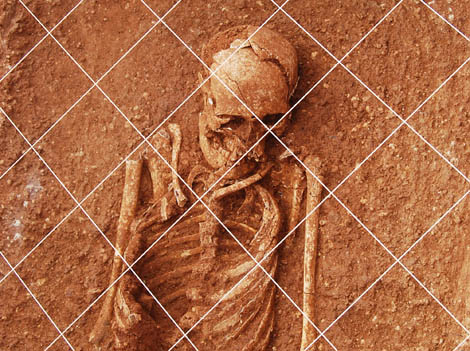 1900 years ago, between the middle of the XNUMXnd and XNUMXrd centuries after Christ, a community of Roman farmers buried their dead, for at least a hundred years, in a place on the banks of the Rio Seco, which today lies on the outskirts of the current city of Faro, next to the athletics track.
1900 years ago, between the middle of the XNUMXnd and XNUMXrd centuries after Christ, a community of Roman farmers buried their dead, for at least a hundred years, in a place on the banks of the Rio Seco, which today lies on the outskirts of the current city of Faro, next to the athletics track.
Where these farmers lived is not known very well today, as no traces of the villa, the large rural farm, where they would have their home and the areas to support agricultural activity, have yet been found.
However, more or less in the same area, at the end of the XNUMXth century, Estacio da Veiga, considered the father of Portuguese archeology, identified a Roman villa in a site he called Amendoal. However, there had been no GPS for over a hundred years and the exact location of this rural Roman settlement has been lost. So it is not known where it was, nor if it had any connection with the Roman necropolis now discovered.
If it is unknown where the people who for nearly two millennia lived in the land in the Rio Seco, on the edge of the EN125, lived, at least it is now expected that the skeletons are relatively well preserved and some – little – remains found in about seven dozen of graves in the necropolis can give investigators clues as to who these Romans were, where and how they lived.
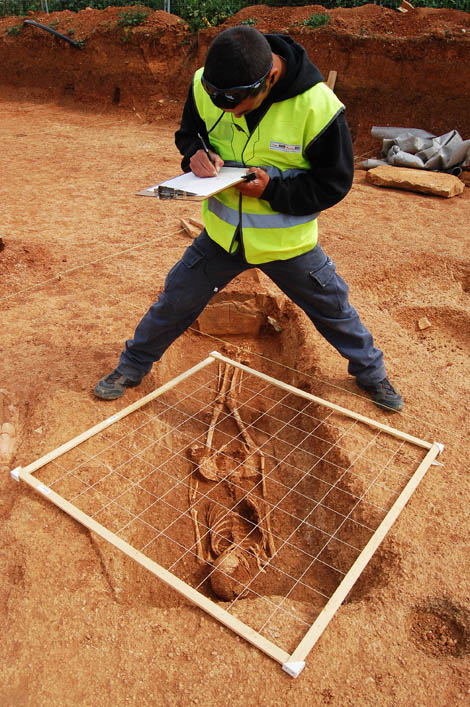 The necropolis was discovered last August, during the archaeological monitoring of the Variant de Faro to the EN125, by technicians from the company Archeocelis, responsible for all monitoring of the rehabilitation works on that road and its variants, from Vila do Bispo almost to Vila Real de Santo António.
The necropolis was discovered last August, during the archaeological monitoring of the Variant de Faro to the EN125, by technicians from the company Archeocelis, responsible for all monitoring of the rehabilitation works on that road and its variants, from Vila do Bispo almost to Vila Real de Santo António.
But the excavation work only began on January 23 this year, having reached a team of 15 people, including archaeologists, archeology students and anthropologists.
According to Teresa Miguel Barbosa, the archaeologist responsible for the work on the necropolis, it is estimated that the intervention will take only two more weeks.
“We are doing all the registrations and surveys of the graves, removing the osteological remains and finally dismantling the structures. After we have finished our work, the works can advance in this location», explained Teresa Barbosa, in an interview with Sul Informação.
Destruction and preservation
While the team of young archaeologists is dedicated to accurately recording, in drawing and photography, the Roman graves found – 67 have been identified so far, but there could be 70 to 72 in the 870 square meters of the intervention – the works of the variant continue to good pace right next door.
Of the necropolis nothing will remain on the land, which will soon be covered by the tar of the new road. The memory of this place, its estate and funerary structures, can only be found later in the Municipal Museum of Faro, where all the material will be deposited.
But don't think that this is the first destruction that the Roman necropolis has suffered. The cemetery originally extended to an area where, in the middle of the last century, an orange grove was planted, between the EN125 and the road to Conceição de Faro.
Agriculture, roads, houses, everything contributed to the destruction, little by little, of the ancient remains, in times when the importance of preserving these testimonies of the past was not much thought.
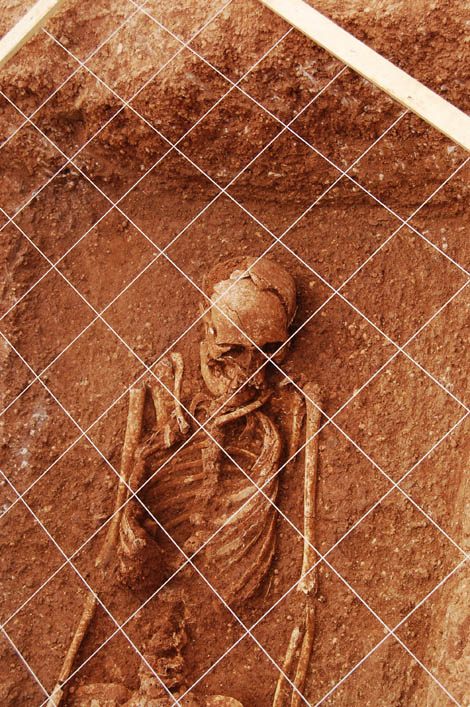 The Athletics Track of Faro, built half a dozen years ago, also contributed to the destruction. At least one of the lane walls was built right on top of Roman graves, destroying them. And, despite the fact that these are recent works, which have already been subject to archaeological monitoring, it does not seem that anyone has ever realized that there were traces there that it would be important to study. Or, if someone noticed...
The Athletics Track of Faro, built half a dozen years ago, also contributed to the destruction. At least one of the lane walls was built right on top of Roman graves, destroying them. And, despite the fact that these are recent works, which have already been subject to archaeological monitoring, it does not seem that anyone has ever realized that there were traces there that it would be important to study. Or, if someone noticed...
Hierarchy in death as in life
So far, 870 Roman tombs have been discovered in the 67 square meters, but it is thought that there could be 72.
“There is a wide variety of typologies of tombs: some simpler, covered with tegulas [flat Roman tile] on single roofs, others in box, with gable roofs, or even amphorae”, explains archaeologist Teresa Barbosa.
"In the Roman period, the hierarchy in life was also found in death." Therefore, some of the graves were more elaborate, probably indicating that the individuals buried there would have a higher social status in the community.
One of the issues that the Archeocelis archaeologist finds interesting is the fact that there are “almost the same number of sub-adults” (youth and children) buried, which may be related to the high infant and young mortality rate at the time. But it can also mean simply that the area of the necropolis investigated by archaeologists was the one where these young people and children were buried…
Another curious fact is the "burying of newborns", of newborns, which, at that time, was not common, as it was thought that children were not really people as long as they were not thinking and autonomous beings, around 4 or 5 years at the very least.
“But here there are a considerable number of newborns, at least 10”, explains the archaeologist.
Also interesting is the discovery of newborns buried in amphorae, a type of burial that had not yet been identified in the Algarve. Four were found here.
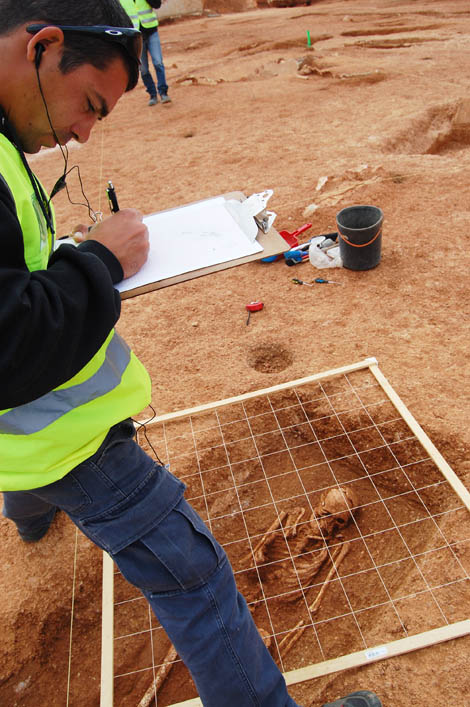
In the graves, there is very little spoil other than the skeletons, which, although relatively well preserved, almost fall apart when the bones are removed from their 1800 to 1900 year rest. “So, before we touch the bones, we make the record as rigorous and complete as possible”, guarantees Teresa Barbosa.
From the previous assessment of the human remains already carried out on site and in the laboratory by the anthropologists who are part of the team, it has already been possible, for example, to identify the most common diseases of this time in this population. And it was found, for example, that most of the people buried there, even children, had very worn teeth, due to a diet very based on hard cereals.
A unique scientific opportunity
The excavations made it possible to identify two areas of occupation of the necropolis, from the middle of the XNUMXnd century to the middle of the XNUMXrd century after Christ.
Carlos Pereira, a PhD student at the Universidade Clássica de Lisboa, has been participating in the excavations of the Rio Seco necropolis because it is an opportunity that does not come up very often.
It's just that, as explained to the Sul Informação, despite the fact that there are many Roman necropolises identified in the Algarve, «few have been intervened recently, with the current methods». In the Roman villa of Milreu, near Estoi, which is half a dozen kilometers away, interventions were carried out in the late XNUMXth century by Estácio da Veiga. But the methods were different and, therefore, "there is not all the information about the necropolis".
Much more recent was the 2004 intervention at Largo 25 de Abril, in Faro, in a necropolis that would be part of the Roman city of Ossonoba. «The structures were typologically very similar to these», guarantees Carlos Pereira.
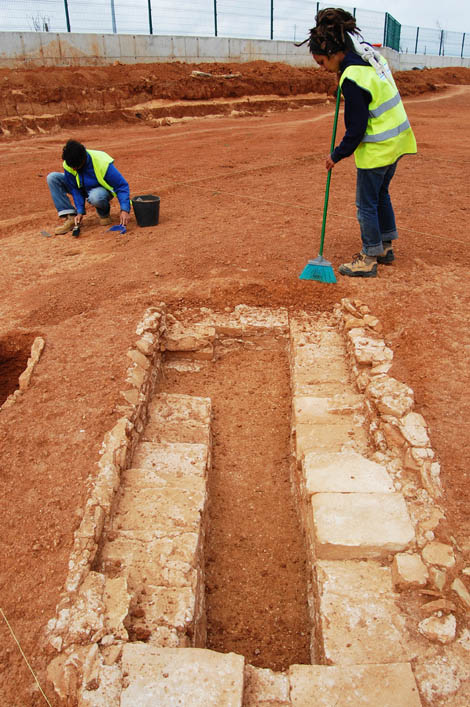 Therefore, the young researcher's hope is that this excavation in the Rio Seco necropolis “provides data that were lacking in other interventions”. “It's not that these data are unprecedented. The point is that we didn't have any current excavations, with current methods and with these dimensions». Hence the scientific interest of this necropolis.
Therefore, the young researcher's hope is that this excavation in the Rio Seco necropolis “provides data that were lacking in other interventions”. “It's not that these data are unprecedented. The point is that we didn't have any current excavations, with current methods and with these dimensions». Hence the scientific interest of this necropolis.
The spoils taken from this necropolis – bones, burial structures, some pieces of pottery – will be deposited in the museum of Faro. But, together with all the investigation, it will also be the object of dissemination, to a more specialized public and, hopefully, to the general public.
Teresa Barbosa said she hopes that the first results of this intervention will be presented in October, at the Algarve Archeology Meeting, which usually takes place in Silves. But there may also be another presentation, more geared towards the lay public, in Faro.
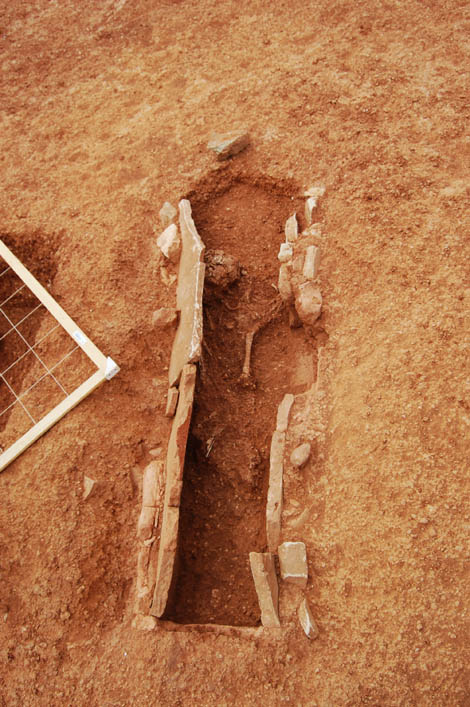


















Comments